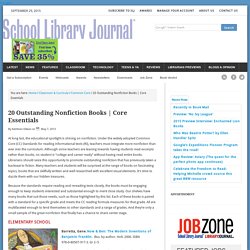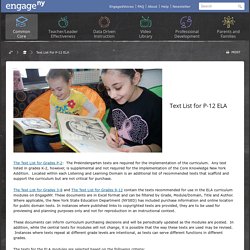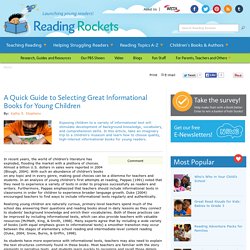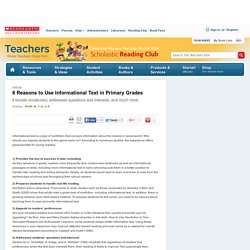

Weekly Reader: Curriculum-Rich Resources for Teachers. Primary books, book, teaching book, book resources, activites. 20 Outstanding Nonfiction Books. At long last, the educational spotlight is shining on nonfiction.

Under the widely adopted Common Core (CC) Standards for reading informational texts (RI), teachers must integrate more nonfiction than ever into the curriculum. Although some teachers are leaning towards having students read excerpts rather than books, no student is “college and career ready” without having read entire books. Librarians should seize this opportunity to promote outstanding nonfiction that has previously taken a backseat to fiction. Many teachers and students will be surprised at the range of books on fascinating topics, books that are skillfully written and well researched with excellent visual elements.
It’s time to dazzle them with our hidden treasures. Because the standards require reading and rereading texts closely, the books must be engaging enough to keep students interested and substantial enough to merit close study. Byrd, Robert. Fritz, Jean. Gibbons, Gail. Kudlinski, Kathleen V. Text List for P-12 ELA. The Text List for Grades P-2: The Prekindergarten texts are required for the implementation of the curriculum.

Any text listed in grades K-2, however, is supplemental and not required for the implementation of the Core Knowledge New York Addition. Located within each Listening and Learning Domain is an additional list of recommended texts that scaffold and support the curriculum but are not critical for purchase. The Text List for Grades 3-8 and The Text List for Grades 9-12 contain the texts recommended for use in the ELA curriculum modules on EngageNY.
These documents are in Excel format and can be filtered by Grade, Module/Domain, Title and Author. Where applicable, the New York State Education Department (NYSED) has included purchase information and online location for public domain texts. These documents can inform curriculum purchasing decisions and will be periodically updated as the modules are posted. The texts for the ELA modules are selected based on the following criteria: A Quick Guide to Selecting Great Informational Books for Young Children. In recent years, the world of children's literature has exploded, flooding the market with a plethora of choices.

Almost a billion U.S. dollars in sales were reported in 2004 (Blough, 2004). With such an abundance of children's books on any topic and in every genre, making good choices can be a dilemma for teachers and students. In an analysis of young children's first attempts at reading, Pappas (1991) noted that they need to experience a variety of texts in order to progress successfully as readers and writers. Furthermore, Pappas emphasized that teachers should include informational texts in classrooms in order for children to experience broader language growth. Duke (2004) encouraged teachers to find ways to include informational texts regularly and authentically. As students have more experience with informational texts, teachers may also need to explain the text structures commonly found in these books.
Cover Imagine walking into a children's museum with a group of eager students. Classroom Connections: Informational Texts and the Common Core, by Terrell A. Young. Krystal. Reading Informational Texts Using the 3-2-1 Strategy. ReadWriteThink couldn't publish all of this great content without literacy experts to write and review for us.

If you've got lessons plans, videos, activities, or other ideas you'd like to contribute, we'd love to hear from you. More Find the latest in professional publications, learn new techniques and strategies, and find out how you can connect with other literacy professionals. More Teacher Resources by Grade Your students can save their work with Student Interactives. More Home › Classroom Resources › Lesson Plans Lesson Plan Overview From Theory to Practice Being able to read informational texts effectively is a fundamental quality of successful readers. Back to top Zygouris-Coe, V., Wiggins, M.B., & Smith, L.H. (2004). Good readers use effective strategies when reading to help them comprehend text. Kletzien, S., & Dreher, M.J. (2004). 6 Reasons to Use Informational Text in Primary Grades. Informational text is a type of nonfiction that conveys information about the natural or social world.

Why should you expose students to this genre early on? According to numerous studies, the experience offers great benefits for young readers. 1) Provides the key to success in later schooling As they advance in grade, readers more frequently face content-area textbooks as well as informational passages on tests. Including more informational text in early schooling puts them in a better position to handle later reading and writing demands. Ideally, all students would read to learn and learn to read from the earliest days of school and throughout their school careers. 2) Prepares students to handle real-life reading Nonfiction text is ubiquitous. 3) Appeals to readers' preferences Are your reluctant readers truly turned off to books, or is the literature they usually encounter just not appealing? 4) Addresses students' questions and interests Studies by U.
Research Sources.